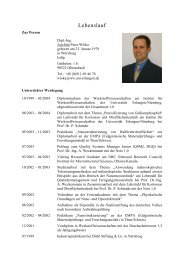Laboratory Safety Instruction - LKO
Laboratory Safety Instruction - LKO
Laboratory Safety Instruction - LKO
Create successful ePaper yourself
Turn your PDF publications into a flip-book with our unique Google optimized e-Paper software.
12. First Aid<br />
Details about First Aid after contact with hazardous materials are provided in the special operating<br />
instructions, in the safety data sheets as well as in the "information about first assistance after effects of<br />
dangerous chemical materials" ("Informationen für die Erste Hilfe bei Einwirken gefährlicher chemischer<br />
Stoffe", GUV 20.10, August 1999).<br />
In the case of health impairment in course of an accident with hazardous materials, in the secretary or<br />
administration an accident form has to be filled out.<br />
Trained First Aid manager: Mrs. Tontsch, Mrs. Marten-Jahns, Tel. 27593<br />
After skin contact: Use safety shower or rinse with a large amount of water. Bad water-soluble<br />
substances rinse with polyethylenglycole (e.g. of Merck, BASF or Roticlean E. Roth). In case of<br />
contact with corrosive or strike-absorptive materials address the medical service.<br />
After eye contact: Immediately use eye wash, sterile eye rinsing solution or rinse eye under<br />
plentiful flowing water while spreading the lid for at least 15 minutes. Protect intact eye against<br />
splashes. While conducting first aid measures prevail some person to call the emergency service.<br />
After swallowing: Immediately emergency service. If necessary submit vomit together with the<br />
package or safety data sheet of the swallowed chemical to the physician.<br />
After inhalation: Take into fresh air. Give Auxiloson or equivalent against materials which attack<br />
the respiratory tract (Auxiloson and its equivalents need prescription; prescription is available<br />
from the occupational emergency service of the FAU). Call the medical service.<br />
After clothing contact: Take off moistened clothes, clean with suitable agents or store it outside.<br />
For further information about poisonings contact the<br />
poison information centre Klinikum Nuernberg-Nord<br />
Tel.: (0911) 398 -2451, - 2665<br />
Fax: (0911) 398 -2192<br />
13. Emergency calls:<br />
fire 09/112<br />
accident (ambulance) 09/19222<br />
from each telephone within the university (except elevator phones)<br />
An EMERGENCY CALL must be made in accordance with the following scheme:<br />
WHERE has the accident occurred<br />
location<br />
WHICH kind of accident occurred<br />
fire, corrosion, fall etc.<br />
HOW MANY injured people<br />
number<br />
WHICH violations<br />
type and part of body<br />
WAIT, until the call is finished by the emergency service. Perhaps it is necessary to answer other<br />
important questions.<br />
8



